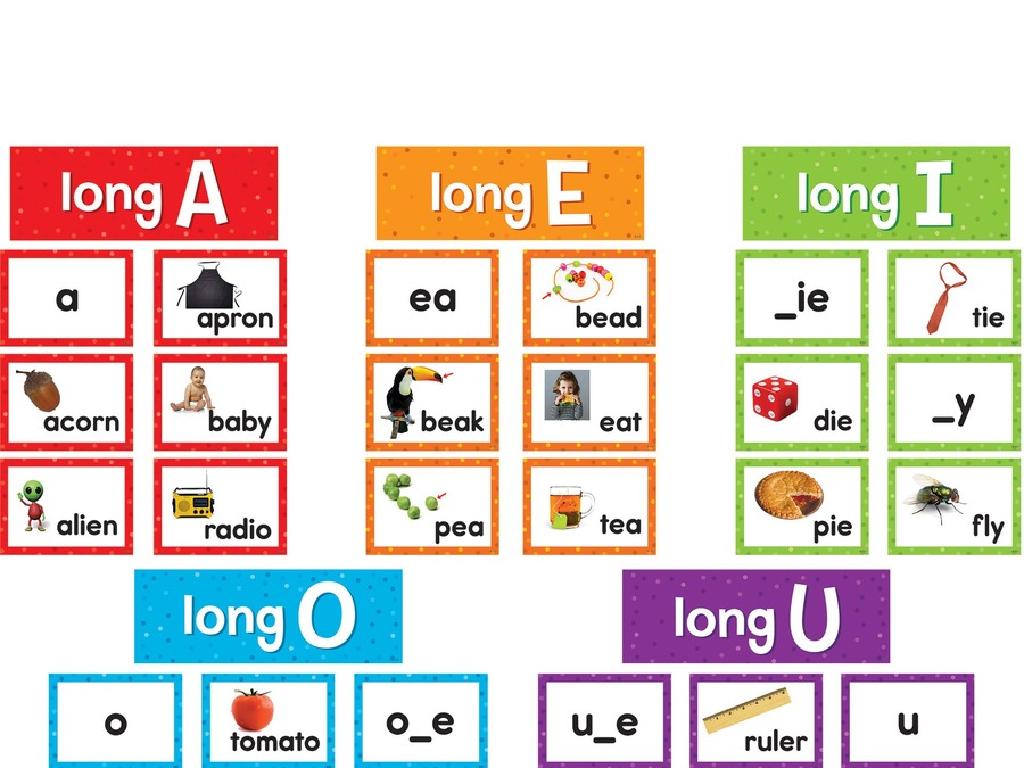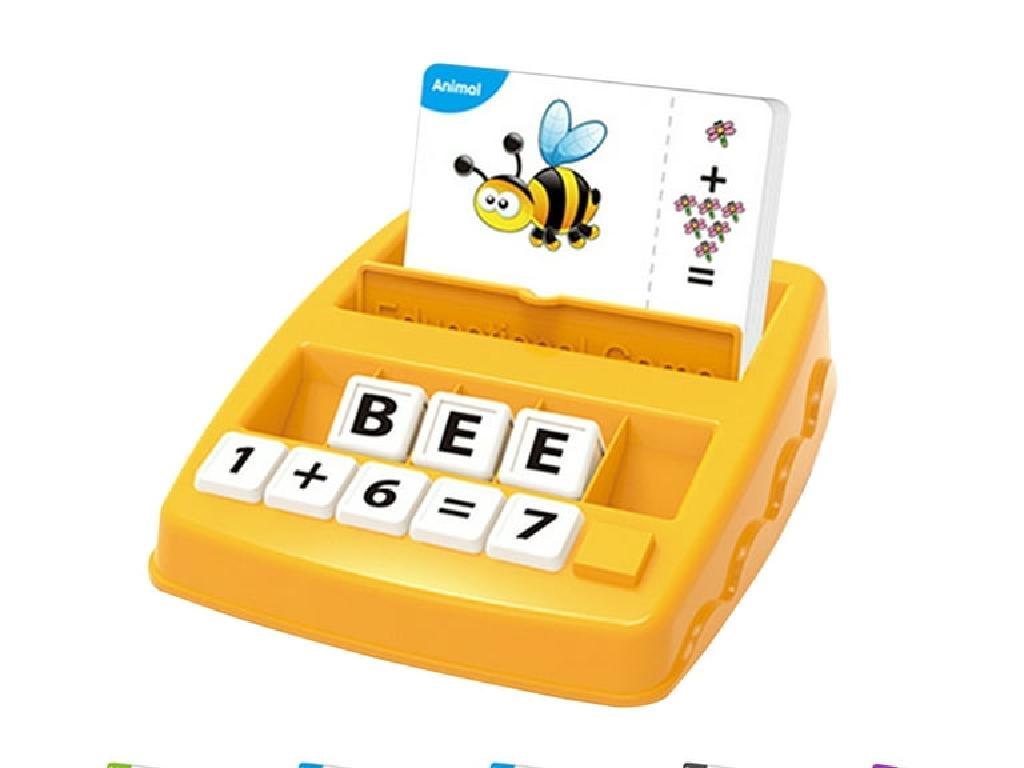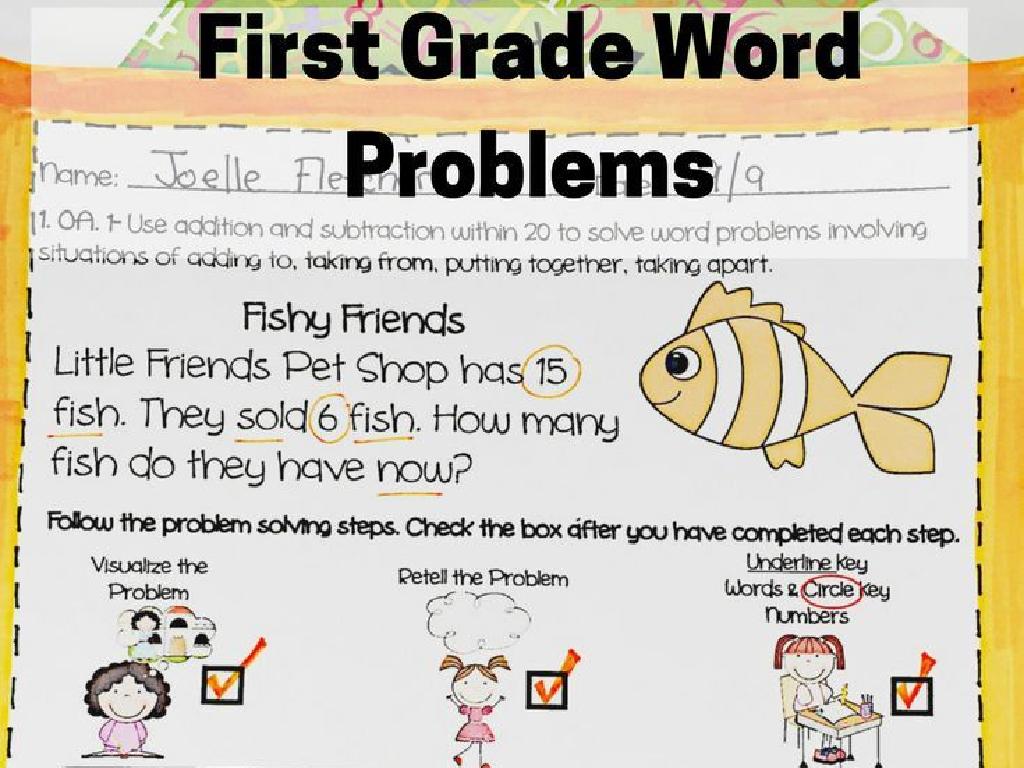Identify Prepositional Phrases
Subject: Language arts
Grade: Third grade
Topic: Prepositions
Please LOG IN to download the presentation. Access is available to registered users only.
View More Content
Welcome to Prepositions!
– Hello and welcome to class!
– What are prepositions?
– Words that show where or when things are
– Today’s goal: Find prepositional phrases
– Phrases that start with a preposition
– Let’s learn and have fun!
|
Begin the class with a warm greeting to make the students feel comfortable. Introduce the concept of prepositions as words that help us describe where something is or when something happens, like ‘on’ a table or ‘before’ dinner. Explain that today’s objective is to identify prepositional phrases, which are groups of words starting with a preposition and ending with a noun or pronoun. Emphasize that understanding prepositional phrases will help them become better writers and readers. Keep the tone light and engaging to encourage participation and excitement about learning new aspects of language arts.
Exploring Prepositions
– What is a preposition?
– Words that link nouns/pronouns to other words
– Common prepositions: in, on, at
– Examples: ‘in’ a box, ‘on’ the table, ‘at’ school
– Prepositions for location
– ‘Under’ the table, ‘beside’ the tree
– Prepositions for time and direction
– ‘Before’ dinner, ‘toward’ the park
|
Introduce prepositions as the building blocks of descriptive language, helping to give more detail in sentences. Start with simple definitions and examples, then show how they can describe where something is (location), when something happens (time), and where something is going (direction). Use visual aids or props to demonstrate prepositions of location. For time and direction, create relatable scenarios, like scheduling an activity or giving directions. Encourage students to come up with their own sentences using prepositions to describe different situations.
Finding Prepositions in Sentences
– Read sentences and find prepositions
– We’ll read sentences aloud as a class and look for prepositions together.
– Understand prepositions’ role
– Prepositions tell us where or when something is in relation to something else.
– Interactive activity: Spot the prepositions
– You’ll see sentences on the slide and use your detective skills to find the prepositions!
– Discuss the information prepositions provide
– Prepositions help us understand the ‘where’ and ‘when’ in stories and instructions.
|
This slide is designed to engage third-grade students in identifying prepositions within sentences. Start by reading sentences aloud and guiding students to recognize prepositions. Emphasize that prepositions are words that show the relationship of a noun or pronoun to another word in the sentence, often indicating location or time. During the interactive activity, display sentences with prepositions in bold or a different color to help students visually identify them. Encourage students to explain how the preposition changes the meaning of the sentence. This activity will help students understand the importance of prepositions in providing context and detail in language. Prepare to offer praise and gentle corrections as students participate.
Exploring Prepositional Phrases
– Prepositional phrase components
– A prepositional phrase starts with a preposition and ends with a noun or pronoun.
– Examples in sentences
– ‘Under the table’, ‘over the rainbow’, and ‘after the party’ are a few examples.
– Adding details with phrases
– Phrases like ‘under the table’ tell us more about where something is.
|
This slide aims to introduce third-grade students to the concept of prepositional phrases in a simple and engaging way. Start by explaining that a prepositional phrase always includes a preposition (a word that shows position or direction) and the noun or pronoun it relates to. Use visual examples and common sentences to show prepositional phrases in context. Emphasize how these phrases add more detail and meaning to a sentence, making our descriptions richer and more vivid. Encourage students to think of their own examples and to identify prepositional phrases in their favorite books or during a classroom reading session.
Let’s Practice Prepositional Phrases!
– Practice with example sentences
– Identify phrases that start with prepositions like ‘on’, ‘in’, ‘under’, etc.
– Write phrases from read-alouds
– Listen carefully and note down the phrases containing prepositions
– Share your phrases with the class
– Discuss what you wrote and learn from others
– Understand prepositions better
|
This slide is for a classroom activity focused on identifying prepositional phrases. Start by explaining that a prepositional phrase begins with a preposition and includes the object it refers to. Read sentences aloud to the class and have students write down the prepositional phrases they hear. Encourage them to share their answers with the class to foster a collaborative learning environment. This activity will help students recognize prepositional phrases in writing and speech, enhancing their grammatical understanding. For the teacher: Prepare a list of sentences rich in prepositional phrases. Consider grouping students and having each group find phrases in different sentences. Offer guidance and clarification as needed.
Create Your Own Sentences with Prepositions
– Craft sentences with prepositional phrases
– Include a prepositional phrase in each sentence you make
– Use newly learned prepositions
– Be creative and try to use prepositions we learned today
– Draw a picture for a sentence
– Choose one sentence and draw a picture that shows what it means
– Share your sentences and drawings
|
This slide is for a class activity where students will apply their knowledge of prepositional phrases by creating their own sentences. Encourage them to be creative and to use the prepositions they’ve learned in class. They should aim to write at least 3-5 sentences. After writing their sentences, ask them to pick one and draw a picture that illustrates the action or the relationship described by the prepositional phrase. This will help solidify their understanding of how prepositions function within a sentence. For the next class, have students share their sentences and drawings, fostering a discussion about the different prepositions and phrases used. Possible activities: 1) Sentence gallery walk, 2) Preposition charades, 3) Drawing interpretations, 4) Prepositional phrase storytelling.
Class Activity: Preposition Scavenger Hunt
– Explore the classroom for objects
– Write sentences with prepositional phrases
– Use phrases like ‘under’, ‘over’, ‘beside’, ‘on’
– Describe the location of each object
– For example, ‘The plant is next to the window.’
– Share your sentences with the class
|
This interactive activity is designed to help students understand and apply the concept of prepositional phrases in a fun and engaging way. By moving around the classroom, students will search for various objects and then write creative sentences that describe the location of these objects using prepositional phrases. Encourage students to think spatially and use a variety of prepositions. After the scavenger hunt, have students share their sentences with the class to reinforce their learning. Possible variations of the activity could include pairing students to work together, using a timer to make it a timed challenge, or having students draw illustrations of their sentences.
Review and Homework: Prepositional Phrases
– Recap on prepositions
– Prepositions are words that show location or time
– Discuss prepositional phrases
– Phrases that start with a preposition and end with a noun or pronoun
– Share today’s learning
– Homework: A story with prepositions
– Write a story and underline phrases like ‘under the table’, ‘during class’
|
As we wrap up today’s lesson, revisit the main points about prepositions and prepositional phrases. Encourage students to share their understanding and what they’ve learned to reinforce their knowledge. For homework, instruct them to write a short story, which will help them apply what they’ve learned in a creative context. They should underline all the prepositional phrases they use, such as ‘under the table’, ‘during class’, or ‘next to the tree’. This exercise will not only solidify their grasp of the concept but also enhance their writing skills. In the next class, you can have a few students share their stories to celebrate their work and discuss the prepositional phrases they included.






